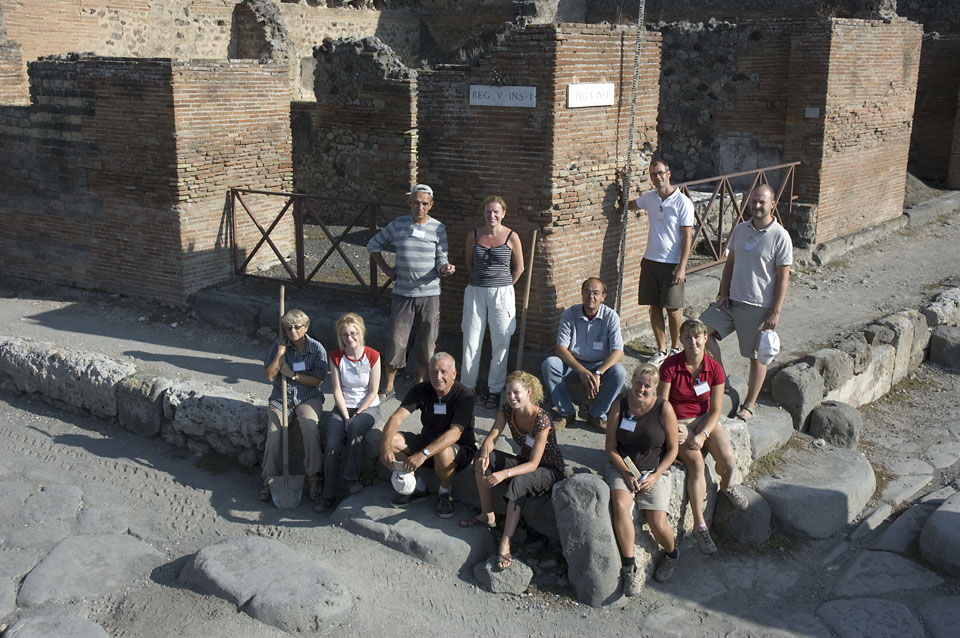Field Campaign 2009
Prof. Anne-Marie Leander Touati, SU: project director
FD Renée Forsell, SU: field director
Doc Arja Karivieri , SU: archaeologist
Thomas Staub, SU: archaeologist
Hans Thorwid, photographer
Mats Holmlund, assistant
Mats Bergman, assistant
Susanna Blåndman, SU: assistant
Fanny Kärfve, LU: trainee
Sascha Olinsson, GU: trainee
Ludmila Werkström, SU: trainee
Richard Olsson, SU: trainee
Hans Hurra Rauch, volunteer
Abstract:
Last year’s new undertakings, Building complex V 1,3 and Casa di Tofelanus Valens (V 1,28), were resumed by Renée Forsell and she also commenced the study of Taberna V 1,31. Except for documenting the standing structures of these buildings, the aim was to locate the inlets and outlets of the water system. Thomas Staub terminated his study on Casa del Torello di bronzo (V 1,7).
Work in Building complex V 1,3
Forsell continued her study of V 1,3 by having the whole floor of the atrium cleared to facilitate Thorwid’s photographic documentation of the water system discovered in 2008. The floors of the fauces, the tablinum (a), the latrina (c) and a corridor (b) that had earlier connected V 1,3 with Casa del Torello di bronzo, were also cleared, documented and photographed. In connection with this work, the water pipe that led the aqueduct water into the atrium was located in the corridor (b). It is now beyond doubt that the water was directed from the economy quarters of Casa del Torello di bronzo, in the north, into V 1,3.
Work in Casa di Tofelanus Valens (V 1,28)
The work in Casa di Tofelanus Valens was now continued by Forsell. In order to find the inlet of the aqueduct water, some minor shallow trenches were made along the western walls of rooms b and f. A small, broken water pipe was located inside a wall in room b, c. 0.7 m above floor level in the southern part of the wall shared with Casa del Torello di bronzo. No further traces of this pipe were found. However, the diameter of the pipe was too small to have functioned as the main conduit of the fountains in Casa del Torello di bronzo. In the southeastern corner of the same room, just below floor level, another pipe with a much wider diameter was then found. This pipe could be followed running below the southern wall and the threshold into room f; it then continued under the western wall of room f towards Taberna 29 which faces Via del Vesuvio. However, since Taberna 29 has an intact cocciopesto floor the pipe could not be traced further.
In the process of cleaning the northern room d, an earlier floor, made of roof tiles and mortar, was exposed. The floor showed signs of being earthquake damaged. In room b was also an earlier floor which tilted strongly. These finds strongly support the hypothesis that the house had been thoroughly repaired after an earthquake.
Work in Taberna V 1,31
The assumption from last year, that the waste water from Building complex V 1,3 was led into a cistern visible in Taberna V 1,31, had to be tested. Forsell had the floor of the taberna cleaned and found that not only the water from V 1,3, but presumably also the water from the neighbouring Taberna V 1,30 was collected in this cistern. Recycled water could be adequate for industrial use in the workshops.
Other activities
This was the last season of work in Casa de Torello di bronzo (V 1,7) by Staub. He finished off by documenting the water conduits connected with the neighbouring buildings in consultation with Forsell.
In the Annex of Casa di Caecilius Iucundus (V 1,23) the Soprintendenza has carried out restoration works since the last campaign. Some parts at the back of the house have now become available for the first time and Karivieri took the opportunity to investigate and document them. Thorwid also completed the photographic documentation of the building.
Report: Renée Forsell
Edited and translated into English by Monica Nilsson

